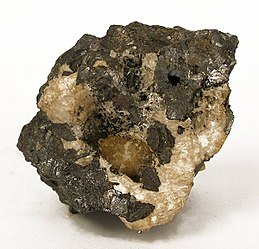| Matlockite | |
|---|---|
 | |
| General | |
| Category | Halide minerals |
| Formula (repeating unit) | PbFCl |
| IMA symbol | Mtl[1] |
| Strunz classification | 3.DC.25 |
| Dana classification | 9.2.11.1 |
| Crystal system | Tetragonal |
| Crystal class | Ditetragonal dipyramidal (4/mmm) H-M symbol: (4/m 2/m 2/m) |
| Space group | P4/nmm |
| Unit cell | a = 4.11 Å, c = 7.23 Å; Z = 2 |
| Identification | |
| Colour | Colourless to yellow and greenish |
| Crystal habit | Flattened, tabular crystals occurring as aggregates, rosettelike, radiating, hemispherical; also massive |
| Cleavage | {001}, perfect |
| Fracture | Uneven to subconchoidal |
| Tenacity | Brittle |
| Mohs scale hardness | 2.5 – 3 |
| Luster | Adamantine, pearly on {001} |
| Diaphaneity | Transparent |
| Specific gravity | 7.1 – 7.2 |
| Optical properties | Uniaxial (−) |
| Refractive index | nω = 2.150 nε = 2.040 |
| References | [2][3][4] |
Matlockite is a rare lead halide mineral, named after the town of Matlock in Derbyshire, England, where it was first discovered in a nearby mine.[3] Matlockite (chemical formula: PbFCl) gives its name to the matlockite group which consists of rare minerals of a similar structure.
- ^ Warr, L.N. (2021). "IMA–CNMNC approved mineral symbols". Mineralogical Magazine. 85 (3): 291–320. Bibcode:2021MinM...85..291W. doi:10.1180/mgm.2021.43. S2CID 235729616.
- ^ Mineralienatlas
- ^ a b Handbook of Mineralogy
- ^ Mindat.org